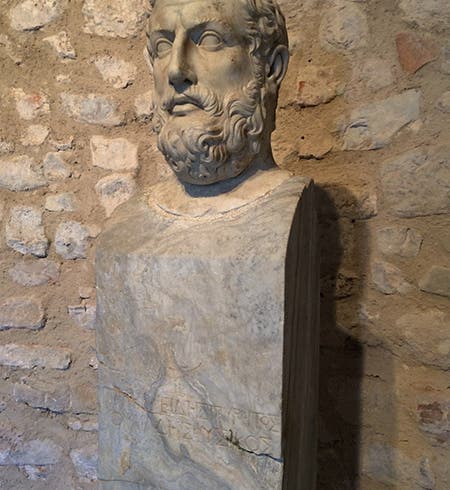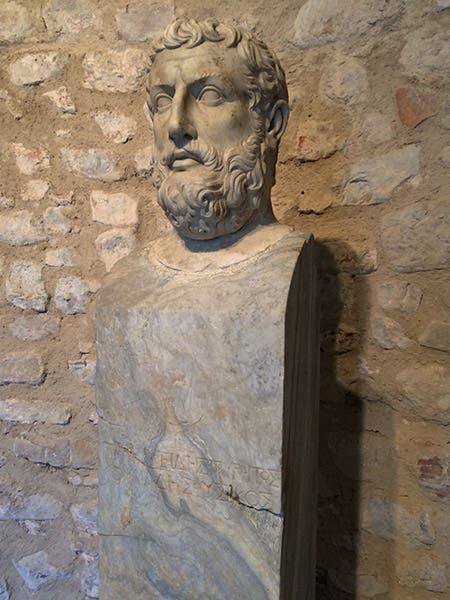Scientist of the Day - Parmenides of Elea
Parmenides of Elea, a pre-Socratic Greek philosopher, flourished around 475 B.C.E.; his birth and death years are unknown. Elea was a thriving Greek colony on the west coast of southern Italy, in a region later known as Magna Graecia. Earlier Greek philosophers, the Ionians, which included Thales of Miletus and Anaximander of Miletus, were interested in determining the fundamental substance of the cosmos. Thales proposed that it was water; his younger colleague Anaximander opted for a more indefinable prime matter that he called apeiron. Because the Ionians took it as axiomatic that there was one and only one fundamental substance, from which all other matter was derived, we call them monists. Anaximenes was a third Milesian monist whom we have profiled in this series. The first criticism of the Milesians came from a slightly later Ionian philosopher, Heraclitus of Ephesus, who argued that the fundamental question of natural philosophy should be the nature of change; why is the world always changing, yet staying pretty much the same? However, Heraclitus was still a monist.
It is not clear how much Parmenides knew about the Milesians, and whether he was aware of Heraclitus, his contemporary, at all. But it almost seems as if Parmenides were addressing Heraclitus directly in the one book that we know he wrote, On Nature. Parmenides was concerned with the essence of being, making him the first ontologist of Western philosophy. He logically determined that if the world is made of "that which is," or Being, and if Being were to change, it could only do so if acted upon by some other agent, or mixed with some other substance. But what else is there in the world to effect such change? Only "that which is not," or non-Being. And non-Being, by definition, does not exist and cannot come into existence. Therefore, concluded Parmenides, Being can never change, and what we see as change in the world is an illusion of our senses.
That was quite a wrench to throw into Ionian natural philosophy. If the world originally consisted of one fundamental substance, then that one substance could never become two or four or anything more than one. The entire premise of Ionian speculation was called into question.
Quite a bit of Parmenides’ book survives, especially the first part, “The Way of Truth,” which is about Being. There is enough there so that modern Parmenides scholars can argue about whether Parmenides was mounting a logical attack on change, or an ontological attack, or something else entirely. You can get an idea of some of these arguments, if you are interested, in the long article on Parmenides in the online Stanford Encyclopedia of Philosophy. But we are concerned here with the effect of Parmenides on succeeding natural philosophers in ancient Greece. He did attract followers, such as Zeno of Elea, who devised paradoxes to demonstrate that change is an illusion, and Zeno and the other students of Parmenides are often referred to as the Eleatic School of pre-Socratic philosophers, and contrasted with the Ionian monists.
Parmenides seems to have stymied the course of monism and called into existence alternative theories of the nature of matter. If it is logically impossible to start a world with one substance and have it change, then perhaps there is more than one fundamental substance. Empedocles would subsequently propose that there are four basic elements: earth, water, air, and fire, and all things are combinations of those elements. Anaxagoras would suggest that every property in the world is determined by a fundamental particle, a seed, that possesses that property, so that there are countless fundamental substances in the world. And Democritus would argue that non-Being does exist, in the form of the void, and change can be produced by the motion and arrangement of atoms – Being – in that void. Much of the remaining half-century of pre-Socratic philosophy would seem to have been a response, in one way or another, to the challenges raised by Parmenides and the Eleatic School.
Greek Elea became the Roman port city of Velia in later times; little of Greek Elea survives but quite a few ruins of Velia can still be seen (second image). In the 1960s, a bust with the name of Parmenides was found in Velia (first image). It may not be an actual portrait, but it might; either way, it is a more substantial memorial than we have for most of the pre-Socratics.
William B. Ashworth, Jr., Consultant for the History of Science, Linda Hall Library and Associate Professor emeritus, Department of History, University of Missouri-Kansas City. Comments or corrections are welcome; please direct to ashworthw@umkc.edu.








